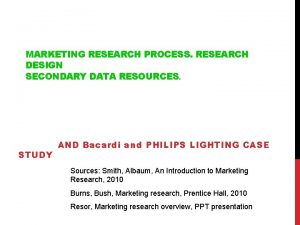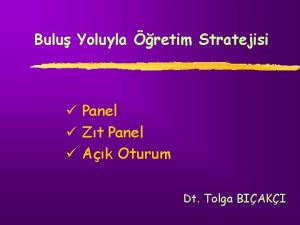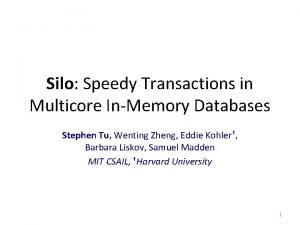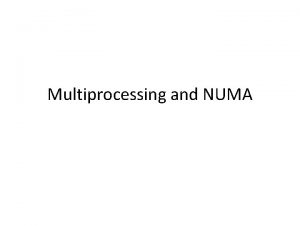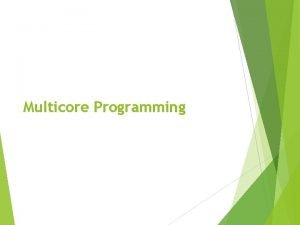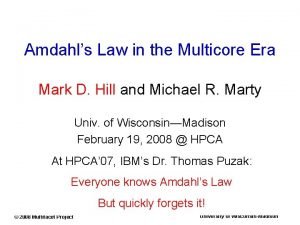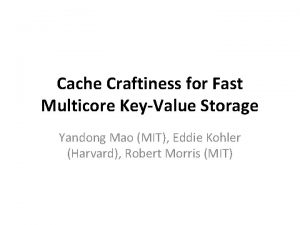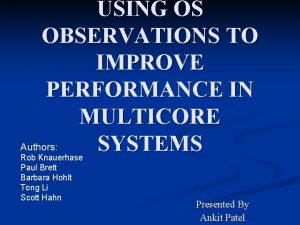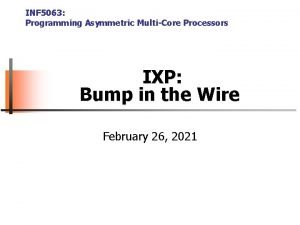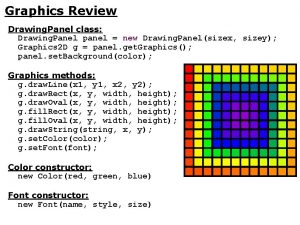Multicore for Science Multicore Panel at e Science










- Slides: 10

Multicore for Science Multicore Panel at e. Science 2008 December 11 2008 Geoffrey Fox Community Grids Laboratory, School of informatics Indiana University gcf@indiana. edu, http: //www. infomall. org 1

Lessons n n Not surprising scientific programs will run very well on multicore systems We need to exploit commodity software environments so not clear that MPI best • Multicore best practice and large scale distributed processing not scientific computing will drive • Although MPI will get good performance On node we can replace MPI by threading which has several advantages: • Avoids explicit communication MPI SEND/RECV in node • Allows very dynamic implementation with # threads changing with time • Asynchronous algorithms Between nodes, we need to combine the best of MPI and Hadoop/Dryad 2

Threading (CCR) Performance: 8 -24 core servers Parallel Overhead 1 -efficiency = (PT(P)/T(1)-1) On P processors = (1/efficiency)-1 1 2 4 8 16 cores 1 2 4 8 16 24 cores Dell Intel 6 core chip with 4 sockets : Power. Edge R 900, 4 x E 7450 Xeon Six Cores, 2. 4 GHz, 12 M Cache 1066 Mhz FSB, 48 Gigabytes memory Intel core about 25% faster than Barcelona AMD core • Clustering of Medical Informatics data • 4000 records – scaling for fixed problem size

• MPI. Net on cluster of 8 16 core AMD systems • Scaled Speed up Parallel Overhead 1 -efficiency = (PT(P)/T(1)-1) On P processors = (1/efficiency)-1 4 -core Laptop Precision M 6400, Intel Core 2 Dual Extreme Edition QX 9300 2. 53 GHz, 1067 MHZ, 12 M L 2 Use Battery 1 Core Speed up 2 Cores Speed up 3 Cores Speed up 4 Cores Speed up 0. 78 2. 15 3. 12 4. 08 Cores Curiously performance for fixed number of cores is (on 2 core Patient 2000) Dell 4 core Laptop 21 minutes Then Dell 24 core Server 27 minutes Then my current 2 core Laptop 28 minutes Finally Dell 8/16 core AMD 34 minutes Fixed Problem size speed up on Laptops

Data Driven Architecture Filter 1 Distributed or “centralized Disk/Database MPI, Shared Memory Compute (Map #1) Disk/Database Memory/Streams Compute (Reduce #1) Disk/Database Memory/Streams Typically workflow Filter 2 Disk/Database Compute (Map #2) Disk/Database Memory/Streams Compute (Reduce #2) Disk/Database Memory/Streams etc. n n Typically one uses “data parallelism” to break data into parts and process parts in parallel so that each of Compute/Map phases runs in (data) parallel mode Different stages in pipeline corresponds to different functions • “filter 1” “filter 2” …. . “visualize” n Mix of functional and parallel components linked by messages 5

Programming Model Implications I n n The distributed world is revolutionized by new environments (Hadoop, Dryad) supporting explicitly decomposed data parallel applications • There can be high level languages • However they “just” pick parallel modules from library – most realistic near term approach to parallel computing environments Party Line Parallel Programming Model: Workflow (parallel-distributed) controlling optimized library calls Mashups, Hadoop and Dryad and their relations are likely to replace current workflow (BPEL. . ) Note no mention of automatic compilation • Recent progress has all been in explicit parallelism 6

Programming Model Implications II n n n Generalize owner-computes rule • if data stored in memory of CPU-i, then CPU-i processes it To the disk-memory-maps rule • CPU-i “moves” to Disk-i and uses CPU-i’s memory to load disk’s data and filters/maps/computes it • Embodies data driven computation and move computing to the data MPI has wonderful features but it will be ignored in real world unless simplified CCR from Microsoft – only ~7 primitives – is one possible commodity multicore messaging environment • It is roughly active messages Both threading CCR and process based MPI can give good (and similar) performance on multicore systems 7

Programming Model Implications III n n n Map. Reduce style primitives really easy in MPI • Map is trivial owner computes rule • Reduce is “just” globalsum = MPI_communicator. Allreduce(partialsum, Operation<double>. Add); With partialsum a sum calculated in parallel in CCR thread or MPI process Threading doesn’t have obvious reduction primitives? • Here is a sequential version globalsum = 0. 0; // globalsum often an array; for (int Thread. No = 0; Thread. No < Count; Thread. No++) { globalsum += partialsum[Thread. No] } Could exploit parallelism over indices of globalsum There is a huge amount of work on MPI reduction algorithms – can this be retargeted to Map. Reduce and Threading 8

Programming Model Implications IV n n n MPI complications comes from Send or Recv not Reduce • Here thread model is much easier as “Send” in MPI (within node) is just a memory access with shared memory • PGAS model could address but not likely to be practical in near future • One could link PGAS nicely with systems like Dryad/Hadoop Threads do not force parallelism so can get accidental Amdahl bottlenecks Threads can be inefficient due to cacheline interference • Different threads must not write to same cacheline • Avoid with artificial constructs like: • partialsum. C[Thread. No] = new double[max. Ncent + cachelinesize] n Windows produces runtime fluctuations that give up to 5 -10% synchronization overheads 9

Components of a Scientific Computing environment n n n My laptop using a dynamic number of cores for runs • Threading (CCR) parallel model allows such dynamic switches if OS told application how many it could – we use short-lived NOT long running threads • Very hard with MPI as would have to redistribute data The cloud for dynamic service instantiation including ability to launch: MPI engines for large closely coupled computations • Petaflops for million particle clustering/dimension reduction? Many parallel applications will run OK for large jobs with “millisecond” (as in Granules) not “microsecond” (as in MPI, CCR) latencies Workflow/Hadoop/Dryad will link together “seamlessly” 10
 Continuous panel vs discontinuous panel
Continuous panel vs discontinuous panel Zıt panel tekniği
Zıt panel tekniği Speedy transactions in multicore in-memory databases
Speedy transactions in multicore in-memory databases Multicore packet scheduler samsung
Multicore packet scheduler samsung Multiprocessor vs multicore
Multiprocessor vs multicore Multicore programming
Multicore programming Amdahl's law in the multicore era
Amdahl's law in the multicore era Cache craftiness for fast multicore key-value storage
Cache craftiness for fast multicore key-value storage Pcie-1429
Pcie-1429 Obs multicore
Obs multicore Asymmetric multicore processing
Asymmetric multicore processing
